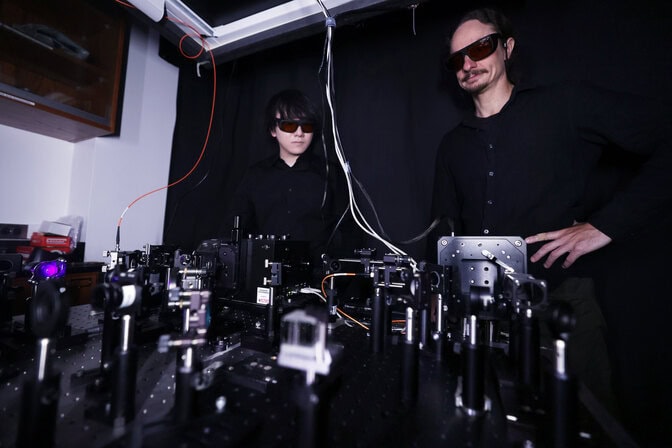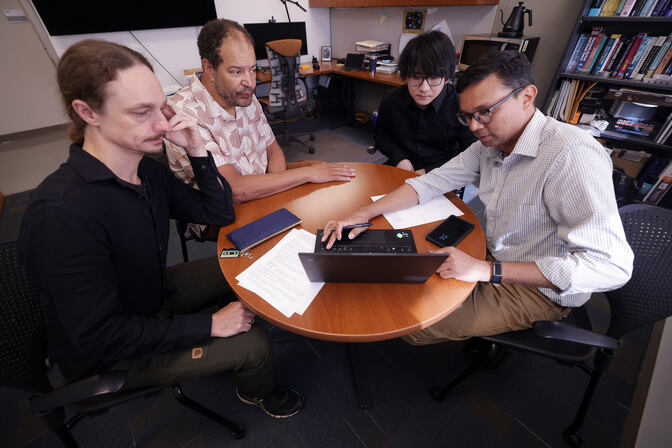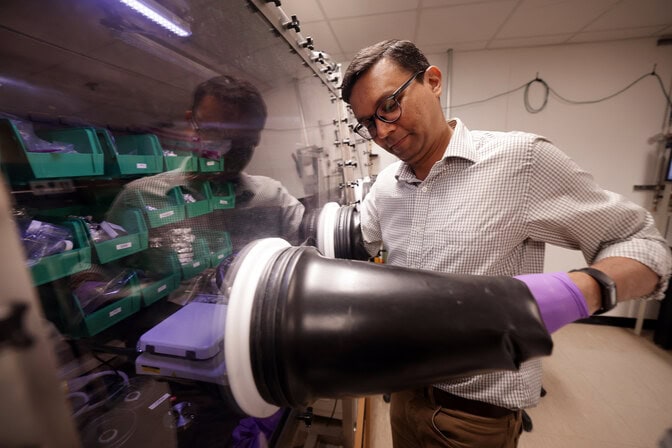
Nano-switch achieves first directed, gated flow of excitons
Moving excitons with light and a nano-ridge could help bridge optics and electronics, enabling new devices and faster, more efficient communication.

Moving excitons with light and a nano-ridge could help bridge optics and electronics, enabling new devices and faster, more efficient communication.
Experts
Doctoral Student of Electrical and Computer Engineering
A new nanostructure acts like a wire and switch that can, for the first time, control and direct the flow of quantum quasiparticles called excitons at room temperature. The transistor-like switch developed by University of Michigan engineers could speed up information transfer or even enable circuits that run on excitons instead of electricity—paving the way for a new class of devices.
Because they have no electrical charge, excitons have the potential to move quantum information without the losses that come with moving electrically charged particles like electrons. These losses drive cell phones and computers to generate heat during use.
“You can see the limits of electronics being reached now with AI and other demanding computations consuming energy and generating heat like crazy. If large processing centers were instead powered by excitonics, you wouldn’t have this huge energy consumption anymore,” said Mack Kira, co-corresponding author of the study in ACS Nano, supervisor of the theory and a professor of electrical and computer engineering.

Though less well-known than electrons, excitons are already commonly used for energy conversion—at work in lights, solar cells and more. The development of the new device was federally funded in part by the U.S. Army Research Office and U.S. Air Force Office of Scientific Research.
“Our cell phone displays work using organic LEDs, which are all excitonic-based,” said Parag Deotare, co-corresponding author, supervisor of the experimental work and an associate professor of electrical and computer engineering. “Plants even convert light into excitons for photosynthesis, then transport that quantum energy packet to where it is needed before converting it into chemical energy.”

Excitons form in semiconductors when an energy source excites an electron, causing it to jump from the ground state to an excited state—like jumping up a rung of a ladder. When the electron jumps, it leaves behind a positively charged vacancy, or ‘hole.’ The negatively charged electron and positively charged hole attract one another and move as a pair, together forming a net neutrally-charged exciton.
While an exciton’s neutral charge enables it to move without losses, it comes with a drawback: it’s hard to move excitons deliberately. Negatively charged electrons are easy to direct in a current because a positively charged electrode attracts them, but that does not work for neutral particles.
To create a device that could manipulate excitons, the team leaned on an approach they had developed earlier, creating an energy landscape in space that pulls excitons along a physical ridge—the exciton equivalent of a wire. Part of the new development is controlling the flow of excitons with electrodes positioned on either side of the ridge that act like a gate.
“When the electrodes are switched on, the voltage creates an energy barrier that prevents the excitons from moving. When the voltage is switched off, the excitons flow again. A switch like this has not been done up to this point,” said Zhaohan Jiang, a doctoral student of electrical and computer engineering at U-M and lead author of the study.

During testing, the device demonstrated an on-off switching ratio exceeding 19 decibels which is a big enough difference to support advanced optoelectronic applications such as high speed on-chip data transfer links, used in advanced supercomputers, data centers, AI-enabled smartphones and wearables, autonomous vehicles, digital twins, and more.
The other part of the new approach is the way it uses light to give the excitons a push in the right direction, making the device an ‘optoexcitonic’ switch. In addition to creating the excitons by causing the electrons to jump energy levels, the light couples with the excitons and helps to drive them along the ridge.

Together, the ridge structure and light interaction successfully transported excitons in a single direction up to 4 micrometers in less than half a nanosecond at room temperature. As a next step, the team aims to connect hundreds of excitonic switches.
“While this technology could become an optoexcitonic circuit as it matures, I see it first improving the interface between photonics and electronics which will speed up processing and communication,” said Deotare.
Such an advancement could be key to meeting the rapidly increasing demand for high-speed data transmission in data centers and possibly AI and machine learning applications.
The team has applied for patent protection with the assistance of U-M Innovation Partnerships.
This device was built in the Lurie Nanofabrication Facility and simulations were run on U-M Advanced Research Computing resources, both of which are operated and maintained with support from indirect cost allocations in federal grants. The grant numbers for the Army Research Office are W911NF-21-1-0207 and W911NF2110116 and those from the Air Force Office of Scientific Research are FA995-22-1-0530, FA99500-21-1-0410 and NSF-DMREF 2118809.